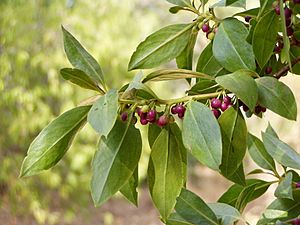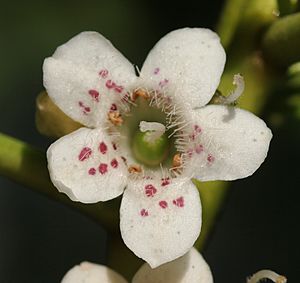Ngaio facts for kids
Quick facts for kids Ngaio |
|
|---|---|
 |
|
| Leaves and fruit | |
| Scientific classification | |
| Genus: |
Myoporum
|
| Species: |
laetum
|
| Synonyms | |
|
|
Myoporum laetum, often called ngaio or mousehole tree, is a special plant. It is a type of plant that grows naturally only in New Zealand, including the Chatham Islands. This plant is part of the Scrophulariaceae family.
Ngaio is a fast-growing shrub or small tree. You can easily spot it by holding its leaves up to the light. You will see many tiny, clear dots!
Contents
What Ngaio Looks Like
Ngaio is an evergreen plant, meaning it stays green all year. It can grow into a small tree, sometimes reaching up to 10 meters (about 33 feet) tall. Its trunk can be about 0.3 meters (1 foot) wide. Sometimes, it spreads out to about 4 meters (13 feet) wide.
When it's young, the plant often looks like a dome. As it gets older, its shape can change as branches break off. Older trees have thick, corky bark with deep lines.
Leaves, Flowers, and Fruit
The leaves of the ngaio tree are shaped like a spear. They are usually between 5 and 12.5 centimeters (2 to 5 inches) long. They are also about 1.5 to 3 centimeters (0.6 to 1.2 inches) wide. As mentioned, they have many see-through dots. The edges of the leaves have small jagged teeth, especially on the outer half.
The flowers are white and have purple spots. They grow in small groups of 2 to 6 flowers on stalks. Each flower has five pointed parts called sepals. It also has five petals that join together at the bottom, forming a bell shape. The flowers are about 1.5 to 2 centimeters (0.6 to 0.8 inches) across.
Ngaio flowers bloom from mid-spring to mid-summer. After the flowers, bright red fruits appear. These fruits are small, about 6 to 9 millimeters (0.2 to 0.4 inches) long.
Where Ngaio Grows
Ngaio loves to grow near the coast in New Zealand. You can find it in lowland forests. Sometimes, it grows all by itself in large groups. Other times, it grows alongside other plants, like the nikau palm (Rhopalostylis sapida).
Ngaio Around the World
People have taken ngaio plants to other countries, such as Portugal, South Africa, and Namibia. In some places, like California, it has grown so well that it is considered an invasive species. This means it can spread quickly and take over areas where other native plants usually grow.
How People Use Ngaio
Traditional Māori Uses
The Māori, who are the native people of New Zealand, used ngaio leaves in a clever way. They would rub the leaves on their skin. This helped to keep annoying mosquitoes and sandflies away!
Growing Ngaio in Gardens
Ngaio is a tough plant that can grow in most types of soil. It needs plenty of sunshine to grow well. It can also handle salty sea spray, which makes it great for coastal gardens. You can grow new ngaio plants from seeds or from cuttings.
Is Ngaio Safe?
It's important to know that the leaves of the ngaio tree contain a natural toxin called Ngaione. This toxin can make animals sick or even cause death. So, animals like horses, cattle, sheep, and pigs should not eat ngaio leaves.
Māori Legend of the Moon
There is a fascinating Māori legend about a ngaio tree on the moon.
The story tells of a woman named Rona. One night, she went to get water from a stream. It was dark, and she tripped over roots and stones. She got angry at the moon, which was hidden behind clouds. Rona shouted at the moon, calling it names.
But the moon goddess heard her! The goddess reached down and pulled Rona up into the sky. Rona tried to grab onto the top of a ngaio tree as she rose. But the tree's roots broke, and so Rona, her water container, and her ngaio tree were placed on the moon forever. It was a warning to anyone who might mock the gods!


